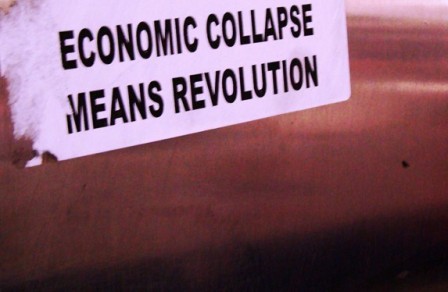Global Capitalism: A Castle Made of Sand
The “Looming Fiscal Cliff”
The United States election charade is finally over. Apparently Wall Street had mixed feeling about either the results or the general health of the global financial market. On November 7, the Dow Jones index dropped by 312 points. Some mentioned increased “concerns about Europe’s financial crisis,” but the discourse in Washington — from both Republicans and Democrats — was about the “looming fiscal cliff” that will occur in January, as soon as a new budget needs to be voted on. The word recession reappears in politicians’ lexicon. Tackling the deficit will entail not only spending cuts, which are the agenda of Republicans, but also higher taxes across the board, which is a notion pushed by Democrats. Among other things, the election cycle served to distract the public from a financial Tsunami building on the horizon.
Fiscal cliff indeed: the US federal debt will reach $16.4 trillion by the end of fiscal year 2012. The budget deficit is projected to reach $17.5 trillion by the end of fiscal year 2013. The fiscal cliff is nothing new, and perhaps today’s financial markets’ index dive was just slightly postponed out of “respect” for the financial “Masters of the Universe” of US politicians’ agenda. Capitalists pretend that “financial markets” know best. Financiers might know a few things, but usually the information is not disclosed to the public until it is too late.
Is a Mega Financial Crash “in the Cards” for 2013?
The global financial crisis of 2008 generated by the US real estate bubble produced a global recession. With the US and European financial situations currently being held by strings, rubber bands and duct tape, the combined fiscal cliff could easily become a global financial crash to make 2008, and even 1929, look like a walk in the park. “Serious” economists did not dare use the term economic depression in 2008, but instead called it a recession. However, the gathering storm coming will make calling a cat a cat unavoidable even for the staunchest proponents of finding justification to shore up disaster capitalism.
Is Fed Chairman Bernanke Tired of Printing Money?
This seems to be the case. A couple of weeks ago, Ben Bernanke quietly announced that he intends to leave the Federal Reserve chairmanship. On October 23, 2012 people close to the Federal Reserve Chairman said that “Bernanke will most likely step down from his position in January 2014, even if President Obama is reelected for a 2nd term.” This information was never confirmed nor denied by Bernanke. However, his desire to retire is easily understandable: after all it must get pretty tiresome to print money around the clock. Chairman Bernanke and the Obama administration use highly academic and purposefully cryptic terms to define the massive money-printing operation. Bernanke describes it alternatively as “monetary stimulus”– the more obvious name — or “quantitative easing”, the more cryptic one. Both consist injecting large amounts of money into the financial system following a Keynesian economic model. US economic academia, with Nobel prize winner Paul Krugman in the lead, are proponents of this approach.
Merkel: Europe’s Accountant in Chief
But on the other side of the Atlantic, Germany — Europe’s healthier economy — as well as the current leadership of the United Kingdom are against this Keynesian approach and favor “fiscal responsibility” in the form of austerity measures, which they are trying to impose on European countries in a fiscal hole such as Greece, Spain, Portugal and to a lesser extent Italy. German Chancellor Angela Merkel views the US policy of extensive monetary stimulus as reckless for the global economy. Merkel was born in what was at the time East Germany. She is not old enough to have directly experienced the impact of the 1929 great depression, but like all Germans, it is likely to be in the back of her mind. In Germany, the late 1920s’ financial crash brought to power Adolf Hitler. Germans were defeated and humiliated by the Treaty of Versailles post World War I, and had to pay reparations to France. This, combined with the global financial crash of 1929 shortly thereafter, made the Deutschmark collapse. In 1932 Germans needed a wheel barrel of Deutschmarks to buy a kilogram of butter. The German currency had become worthless paper.
Road to Perdition: Fire Sale of US Treasury Bonds Held by Foreign Countries
Another factor to input in the fractured equation of global finance is the large amount of US Treasury bonds held by foreign nations. The US can posture as much as it wants to, but in reality — especially in the cases of China and Japan — the US government has a massive financial canon right up to its head. According to the US Treasury, China’s holding in bonds was $1.15 trillion in August 2012, Japan held $1.12 trillion. Smaller bonds holders such as Brazil, Switzerland, the UK, Russia and others all combined held about another $1.8 trillion. Overall, we are talking about $4.0 trillion and this does not include holders from transnational corporate entities.
Financial Hurricanes and Typhoons on the Horizon
A fire sale of US Treasury bonds could, on its own, collapse the castle made of sand. But if you combine it with an attack on Iran and oil prices doubling or perhaps more, we have a recipe for the mother of all great depressions. People in New York and New Jersey are exposed to the misery of fighting natural forces with little help from a broken government. But the massive financial hurricanes and typhoons that are about to sweep the planet from West to East and North to South will not spare anyone. All of us are in the same boat, and it is looking more and more like the Titanic right before hitting the iceberg.
Related Articles




















You must be logged in to post a comment Login